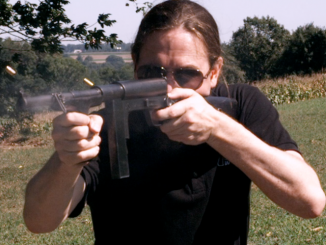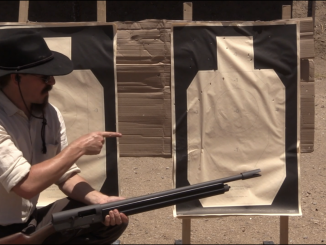My recent trip to the Rock Island Auction house was spent taking a whole slew of videos on guns that are coming up for sale in their Premier auction on the 12th, 13th, and 14th of September. I’ll be putting out one each day for pretty much the next 3 weeks – lots of great video for you guys, covering all sorts of interesting guns! Today we’ll kick things off with an 1875 Lee Vertical Action Carbine…
The 1875 Lee Vertical Action was an experimental rifle designed by James Paris Lee (of Lee Enfield and Lee Navy fame) as an idea to increase the rate of fire from single-shot Army rifles. He touted an impressive 30 rounds in 45 seconds with the rifle, thanks to several design elements that combined to make a very fast manual of arms. In total only 143 of these guns were made at Springfield Armory, and this example is the only known carbine variant. It will be up for sale on September 14, 2014 at Rock Island Auctions – see the link above.




nice to see that you got a table and a quiet room to record your videos
Agreed. I’m really hoping they toss a few bucks his way as well. Those videos can’t hurt theirs sales.
Overall, it looks like a basic Peabody falling-block breech with an operating system very similar to the Bavarian Werder “Lightning” rifle. On the Werder, the breech was “dropped” by pushing forward on a “reverse trigger” in the front of the trigger guard (which released the breechblock catch) and was closed by simply hauling its big mule-ear cocking piece back to full cock.
The Werder system was used in both rifles and pistols, and both were still in use in the Balkans during World War One.
(Smith, Small Arms of the World, 9th edition, pp.50-51.)
cheers
eon
There’s something very interesting going on with that breech block’s pivot/fulcrum to bring the back of the block into contact with the locking surfaces above the bore axis. It doesn’t look like it’s acting simply as a hinge.
The pivot itself appears top be approximately on the bore axis. I’ll have to get a look at that patent when I get back in, to see what’s going on.
Most of the Martinis have the pivot well above the bore axis – however Greener patented the idea of re-boring the threads for the barrel to drop the muzzle down, bringing the imaginary rearward continuation of the bore axis almost through the centre of the pivot pin. That allowed the feeding of a 12 guage case over a .577/.450 bolt trough, also for a cleaning rod to pass through the bore from the rear, and for the bore to be inspected from the rear.
Ps
I think I’ve just gone off J P Lee, rent seeker 🙁
Fascinating video. Lee really does seem to be a brilliant designer who is often overlooked in the popular gun press. His Model 1879 was a very advanced design for its time (magazine-fed bolt action repeater), and his Remington M 1885 is one of my personal favorites (I am always tempted to bring it to a cowboy match just to see the reactions). I wonder if this Remington produced carbine was an attempt to gain foreign contracts for the rifle in addition to a US contract or in case the US trials didn’t pan out. Their rolling block rifles were quite popular abroad and this may have been an attempt to make additional sales in an established and lucrative market. All in all, an interesting and well designed rifle. Nice find, Ian.
“Lee really does seem to be a brilliant designer who is often overlooked in the popular gun press.”
The greatest idea of Lee was to use detachable box magazine that can be loaded by charger clip in rifle. With tubular magazine the center-of-gravity go as the magazine was emptied, the capacity was restricted by rifle length and cartridge must be loaded one-by-one.
Not to mention, the tubular magazine limited the rifle to using round-nosed bullets. With pointed Spitzer-type projectiles, the rifle’s recoil could force the point of the next round into the primer of the round ahead of it, causing it to detonate inside the magazine tube with catastrophic results. Lee’s box magazine allowed for (if perhaps only indirectly) the practical development and implementation of the modern rifle projectiles, among other things. (6.5mm Lee Navy, for example)
I am wondering when the carbine was made – from scratch as a factory prototype or it was rebuild from rifle configuration by later user.
Very novel interpretation of a Martini that, I like it.
Was the Lee’s ejector purely spring driven, or was it connected to the block so that when you struck the back of the hammer it transmitted a blow to the ejector? If it didn’t rely solely on spring force, just how much extraction force could be practically applied?
The Martini was found to have a problem with ejecting cases in severe conditions. After firing for a while, the cases would tend to stick. This was more of a problem in those days given the powders and case designs. They ended up extending the lever to give the user more mechanical advantage. I have to wonder how well other rifles dealt with this problem, which the British only discovered by using their rifles in actual wars.
The extended lever mainly served to tear the cartridge case head off with greater efficiency. The problem was that the British Army was required (by their parliamentary “paymasters”)to use cartridge cases consisting of a rolled copper foil “tube” soldered to a “battery cup” cartridge head made of iron, much like the brass head of a modern shotgun shell. Simply put, they were cheap to make.
In tropical temperatures especially, the heat of firing tended to “braze” the copper foil to the chamber wall, and resulted in the iron “head” being torn away by the extractor.
The real answer was to go to a drawn-brass, one-piece cartridge case with a sufficiently thick “web” near the head to ensure that it stayed together when extracted. The British Army finally got such cases for the .577/450 Martini-Henry in the early 1880s. Exactly what effect the older cases had at battles like Isandhlwana and Majuba Hill may never be known.
By that time, the U.S. Army and Marine Corps had been using drawn-brass cases in everything for over fifteen years.
The U.S. Army used drawn-brass cases exclusively from the time it adopted the first of its “Trapdoor” Springfield breechloading rifles, the Model 1868 in .50 rimfire. Firstly, it was next to impossible to make a rimfire cartridge case in any way except using a one-piece, drawn case, and secondly, the Army had had enough bad experiences with case separations in Civil War breechloaders like the Burnside and Gallagher cavalry carbines (both of which initially used “foil” copper cases) to be wary of such in higher-powered weapons with greater breech pressure.
BTW, it paid off. Archeological work at the Little Big Horn battle site in the last two decades has shown that contrary to legend (and some Army reports that may have been CYA), Custer’s men did not have a large number of their carbines rendered unusable by case-head separations; the Indians actually had a greater percentage of case separations in their Remingtons and etc. than the Seventh did. Custer lost due to being outmaneuvered, outnumbered, and outgunned.
I’m sure war chief Chali At Pun of the Chiricahua Apache wished General Crook’s men had been using “coiled cases”. When he surrendered in 1878, he told Crook, “Demasiados cartuchos del cobre”. (“You have too many copper cartridges.”)
cheers
eon
“drawn-brass, one-piece cartridge”
Note that also Greener shotgun use full-metal shotshell, with exterior appearance similar to blank cartridge
http://www.municion.org/greener/12-14Police.htm
is there anyone making reproductions of this rifle? because I this would be very interesting to shoot
None I’m aware of, unfortunately.
if only we knew a skilled gunsmith that would be capable of doing that
That is easily one of the most beautiful firearms I have every seen!
i am not familiar with this sort of action so i went looking for the patient
i didn’t find it but i did find a Rare Cutaway Demonstrator Model of a Lee Single Shot Breech Loading Rifle Action
http://www.rockislandauction.com/viewitem/aid/55/lid/1328
But you did find the patents. I read the article in the images at the link you posted and found patent #122772 for the original and #193821 for an improved model.
Should be, 160919 the first patent number.
I worded that poorly. I should have said #122772 was the earliest patent on the design. #160919 is the earliest patent on the whole rifle, but #122772 references key design elements, specifically striking the back of the hammer to drop the breech block. Thanks for finding that patent, though. I looked for about a half an hour, but couldn’t find it.
Very cleverly designed weapon and testimony to American inventiveness. Thanks for video!